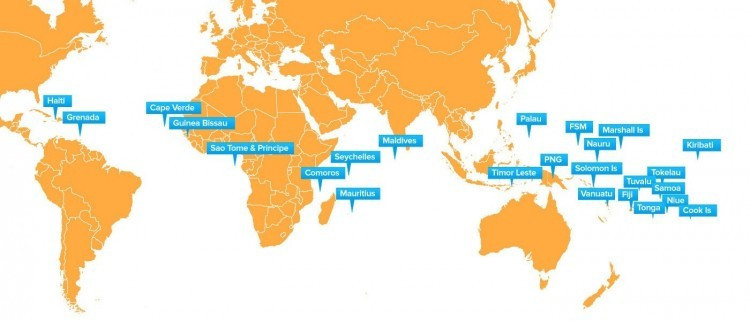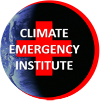Small Islands
In 2011 UNEP The United Nations Environment Program recently released a report on the vulnerability of freshwater resources in Pacific Island Countries. While climate change was not the overall focus of the assessment, the authors note that many small Pacific islands are particularly vulnerable to water scarcity due to climate change. Aside from the risk of flooding due to sea level rise, islands are vulnerable because of their hydrology.
Typically, small islands have several layers of groundwater, the lowest level of which is salty. A lens of fresh groundwater floats on top of the salty groundwater, with a brackish transition layer at the boundary between the two. Where the transition between fresh and salty groundwater occurs depends on how thick the fresh water is, because the weight of the fresh water pushes the salt water down somewhat. During droughts, not only does the top of the water table fall, as happens on larger landmasses, but with less fresh water to push it down, the salty layer rises. Since the salt layer is also rising due to sea level rise from climate change, the prospect of wells becoming salty during droughts is becoming more likely. Since during a drought is when these islands typically depend on groundwater, the increased possibility of wells becoming salty is quite serious.
Typically, small islands have several layers of groundwater, the lowest level of which is salty. A lens of fresh groundwater floats on top of the salty groundwater, with a brackish transition layer at the boundary between the two. Where the transition between fresh and salty groundwater occurs depends on how thick the fresh water is, because the weight of the fresh water pushes the salt water down somewhat. During droughts, not only does the top of the water table fall, as happens on larger landmasses, but with less fresh water to push it down, the salty layer rises. Since the salt layer is also rising due to sea level rise from climate change, the prospect of wells becoming salty during droughts is becoming more likely. Since during a drought is when these islands typically depend on groundwater, the increased possibility of wells becoming salty is quite serious.
Climate Emergency Institute
IPCC 2014 AR5
Small Islands
Executive Summary
Current and future climate-related drivers of risk for small islands during the 21st century include sea level rise (SLR), tropical and extratropical cyclones, increasing air and sea surface temperatures, and changing rainfall patterns (high confidence; robust evidence, high agreement).
Current impacts associated with these changes confirm findings reported on small islands from the Fourth Assessment Report (AR4) and previous IPCC assessments. The future risks associated with these drivers
include loss of adaptive capacity and ecosystem services critical to lives and livelihoods in small islands.
SLR poses one of the most widely recognized climate change threats to low-lying coastal areas on islands and atolls (high confidence; robust evidence, high agreement). It is virtually certain that global mean SLR rates are accelerating.
Projected increases to the year 2100 superimposed on extreme sea level events (e.g., swell waves, storm surges, El Niño-Southern Oscillation) present severe sea flood and erosion risks for low-lying coastal areas and atoll islands. Likewise, there is high confidence that wave over-wash of seawater will degrade fresh groundwater resources and that sea surface temperature rise will result in increased coral bleaching and reef degradation. Given the dependence of island communities on coral reef ecosystems for a range of services including coastal protection, subsistence fisheries, and tourism, there is high confidence that coral reef ecosystem degradation will negatively impact island communities and livelihoods.
Given the inherent physical characteristics of small islands, the AR5 reconfirms the high level of vulnerability of small islands to multiple stressors, both climate and non-climate (high confidence; robust evidence, high agreement).
There is increasing recognition of the risks to small islands from climate-related processes originating well beyond the borders of an individual nation or island. Such transboundary processes already have a negative impact on small islands (high confidence; robust evidence). These include air-borne dust from the Sahara and Asia, distant-source ocean swells from mid to high latitudes, invasive plant and animal species, and the spread of aquatic pathogens. For island communities the risks associated with existing and future invasive species and human health challenges are projected to increase in a changing climate.
The IPCC suggests adaptation benefits small islands to the extent of reducing risks, even with global warming as high as 4C. This is contyradicted by the projections and multiple devastating impacts and practically impossible at above a 1.5C global warming over the long term, as the Small Island States has complained of for many years.
Small Islands
Executive Summary
Current and future climate-related drivers of risk for small islands during the 21st century include sea level rise (SLR), tropical and extratropical cyclones, increasing air and sea surface temperatures, and changing rainfall patterns (high confidence; robust evidence, high agreement).
Current impacts associated with these changes confirm findings reported on small islands from the Fourth Assessment Report (AR4) and previous IPCC assessments. The future risks associated with these drivers
include loss of adaptive capacity and ecosystem services critical to lives and livelihoods in small islands.
SLR poses one of the most widely recognized climate change threats to low-lying coastal areas on islands and atolls (high confidence; robust evidence, high agreement). It is virtually certain that global mean SLR rates are accelerating.
Projected increases to the year 2100 superimposed on extreme sea level events (e.g., swell waves, storm surges, El Niño-Southern Oscillation) present severe sea flood and erosion risks for low-lying coastal areas and atoll islands. Likewise, there is high confidence that wave over-wash of seawater will degrade fresh groundwater resources and that sea surface temperature rise will result in increased coral bleaching and reef degradation. Given the dependence of island communities on coral reef ecosystems for a range of services including coastal protection, subsistence fisheries, and tourism, there is high confidence that coral reef ecosystem degradation will negatively impact island communities and livelihoods.
Given the inherent physical characteristics of small islands, the AR5 reconfirms the high level of vulnerability of small islands to multiple stressors, both climate and non-climate (high confidence; robust evidence, high agreement).
There is increasing recognition of the risks to small islands from climate-related processes originating well beyond the borders of an individual nation or island. Such transboundary processes already have a negative impact on small islands (high confidence; robust evidence). These include air-borne dust from the Sahara and Asia, distant-source ocean swells from mid to high latitudes, invasive plant and animal species, and the spread of aquatic pathogens. For island communities the risks associated with existing and future invasive species and human health challenges are projected to increase in a changing climate.
The IPCC suggests adaptation benefits small islands to the extent of reducing risks, even with global warming as high as 4C. This is contyradicted by the projections and multiple devastating impacts and practically impossible at above a 1.5C global warming over the long term, as the Small Island States has complained of for many years.


IPCC AR6 Small Island Fact sheet
https://www.ipcc.ch/report/ar6/wg1/downloads/factsheets/IPCC_AR6 _WGI_Regional_Fact_Sheet_Small_Islands.pdf
Observed warming in the Small Islands has been attributed to human influence.
Warming will continue in the 21st century for all global warming levels and future emissions
https://www.ipcc.ch/report/ar6/wg1/downloads/factsheets/IPCC_AR6 _WGI_Regional_Fact_Sheet_Small_Islands.pdf
Observed warming in the Small Islands has been attributed to human influence.
Warming will continue in the 21st century for all global warming levels and future emissions
scenarios, further increasing heat extremes and heat stress (high confidence).
• Ocean acidification has increased globally as have the frequency and intensity of marine heatwaves in some areas of the Indian, Atlantic and Pacific Oceans except for a decrease over the eastern Pacific Ocean.
Marine heatwaves and ocean acidification will increase further with 1.5°C of global warming (high confidence) and with larger increases at 2°C and higher.
• Sea levels will very likely continue to rise around Small Islands, more so with higher emissions and over longer time periods (high confidence).
• Sea level rise coupled with storm surges and waves will exacerbate coastal inundation and the potential for increased saltwater intrusion into aquifers (high confidence).
• Sea level rise will cause shorelines to retreat along sandy coasts of most Small Islands.
• Small Islands will face more intense but generally fewer tropical cyclones, except in the central north Pacific where frequency will increase at a global warming level of 2°C and above.
IPCC AR6 Small Island Chapter
https://www.ipcc.ch/report/ar6/wg2/downloads/report/IPCC
_AR6_WGII_Chapter15.pdf
Small islands are increasingly affected by increases in temperature
IPCC AR6 Small Island Chapter
https://www.ipcc.ch/report/ar6/wg2/downloads/report/IPCC
_AR6_WGII_Chapter15.pdf
Small islands are increasingly affected by increases in temperature
Tropical Cyclones
The growing impacts of tropical cyclones (TCs), storm surges, droughts,
The growing impacts of tropical cyclones (TCs), storm surges, droughts,
changing precipitation patterns, sea level rise (SLR), coral bleaching and
invasive species, all of which are already detectable across both natural
and human systems (very high confidence)
TCs are severely impacting small islands (high confidence). The TC intensity and intensification rates at a global scale have increased in the past 40 years with intensity trends generally remaining positive.
TCs are severely impacting small islands (high confidence). The TC intensity and intensification rates at a global scale have increased in the past 40 years with intensity trends generally remaining positive.
Intense TCs including Categories 4 and 5 TCs have threatened human life and destroyed buildings and infrastructural assets in small islands in the Caribbean and the Pacific. Among 29 Caribbean islands, 22 were
affected by at least one Category 4 or 5 TC in 2017. TC Maria in 2017 destroyed nearly all of Dominica’s infrastructure and losses amounted to over 225% of the annual GDP. Destruction from TC Winston in 2016
exceeded 20% of Fiji’s current GDP. TC Pam devastated Vanuatu in 2015 and caused losses and damages to the agricultural sector valued at USD 56.5 million (64.1% of GDP). Coast-focused tourism is already extremely impacted by more intense TCs
Low lying small islands are the most vulnerabe geographic region to global warming due to sea level rise and more powerful storms
